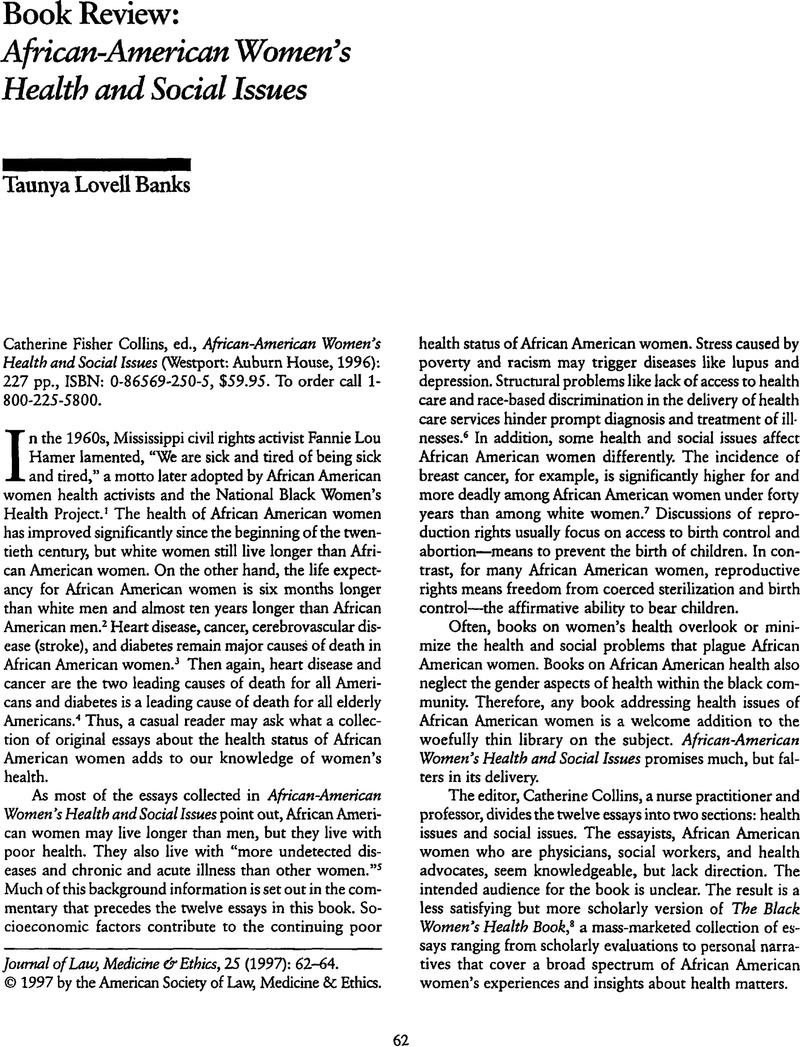No CrossRef data available.
Article contents
Book Review: African-American Women's Health and Social Issues
Review products
CollinsCatherine Fisher, ed., African-American Women's Health and Social Issues (Westport: Auburn House, 1996): 227 pp., ISBN:0-86569-250-5, $59.95. To order call 1-800-225-5800.
Published online by Cambridge University Press: 01 January 2021
Abstract
An abstract is not available for this content so a preview has been provided. Please use the Get access link above for information on how to access this content.

- Type
- Book Review
- Information
- Copyright
- Copyright © American Society of Law, Medicine and Ethics 1997
References
See id.Google Scholar
See id.Google Scholar
Collins, C.F., “Commentary on the Health and Social Status of African-American Women,” in Collins, C.F., ed., African-American Women's Health and Social Issues (Westport: Auburn House, 1996): 1–10.Google Scholar
Watson, S.D., “Minority Access and Health Reform: A Civil Right to Health Care,” Journal of Law, Medicine & Ethics, 22 (1994): 127–37.CrossRefGoogle Scholar
Perera, F.P., “Molecular Epidemiology: Insights into Cancer Susceptibility, Risk Assessment, and Prevention,” Journal of the National Cancer Institute, 88 (1996): 496–509. Conversely, cancer rates among white women over forty are significantly higher than for African American women.CrossRefGoogle Scholar
Crawford-Green, C., “Hypertension and African-American Women,” in Collins, , ed., supra note 5, at 59–73.Google Scholar
Brooks-Bertram, P., “African-American Women: Disfigured Images in the Epidemiology of Depression,” in Collins, , ed., supra note 5, at 107–32.Google Scholar
See id. at 124.Google Scholar
Collins, C.F., “Focus on African-American Women and Diabetes,” in Collins, , ed., supra note 5, at 75–86.Google Scholar
Jackson, J.D.S., “Alcohol Abuse and Stress Among African-American Women,” in Collins, , ed., supra note 5, at 87–106.Google Scholar
Sullivan, E.G., “Lupus: The Silent Killer,” in Collins, , ed., supra note 5, at 25–35.Google Scholar
See id. at 32.Google Scholar
Roberson, N.L., “Exploring Health Issues and Health Status of African-American Women with Emphasis on Cancer,” in Collins, , ed., supra note 5, at 37–58.Google Scholar
Daniel, R.B., “Allowing Illness in Order to Heal: Sojourning African-American Women and the AIDS Pandemic,” in Collins, , ed., supra note 5, at 13–24.Google Scholar
For a discussion of these issues, see Banks, T.L., “The Americans with Disabilities Act and the Reproductive Rights of HIV-infected Women,” Texas Journal of Women & Law, 3 (1994): 57–98; and Banks, T.L., “Women and AIDS: Racism, Sexism and Classism,” New York University Review of Law & Social Change, 17 (1989–90): 351–85.Google Scholar
Nevergold, B.A.S., “Transracial Adoption: In the Child's Best Interest?,” in Collins, , ed., supra note 5, at 165–86.Google Scholar
Barbara Nevergold concedes that most studies comparing transracial and intraracial adoptions find little difference in adjustment, but she argues that African American children adopted by white couples are more acculturated (less likely to identify with African American culture) than children adopted intraracially. She concludes that the “best interest of the child” standard as currently defined discounts the importance of providing African American children with race-related survival skills and cultural knowledge when making adoption decisions. For a legal discussion adopting this perspective, see Perry, T.L., “The Transracial Adoption Controversy. An Analysis of Discourse and Subordination,” New York University Review of Law & Social Change, 21 (1993): 33–108; cf., Bartholet, E., “Where Do Black Children Belong? The Politics of Race Matching in Adoption,” University of Pennsylvania Law Review, 139 (1991): 1163–256.Google Scholar
Fryar, I.L.B., “The Roots of Coping Behavior for African-American Women: A Literary Perspective,” in Collins, , ed., supra note 5, at 199–212.Google Scholar


